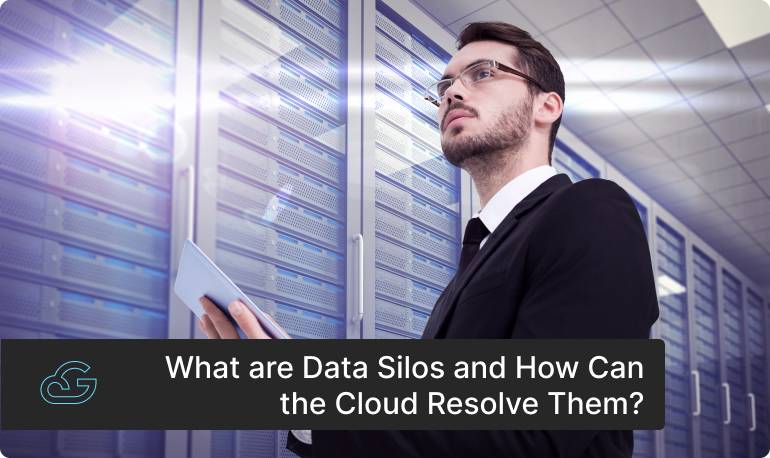Blogs / Hybrid Cloud
What are Data Silos and How Can the Cloud Resolve Them?
By
Sibin Vincent
Posted: February 5, 2025
• 7 Minutes
Global businesses today are operating in a data economy. Therefore, as business leaders, you must build an ecosystem where data is constantly collected, organized, and exchanged to create economic value. But doing so is difficult. Especially when it comes to designing data pipelines that facilitate the seamless exchange of data. And without these data pipelines, huge volumes of your enterprise data will get isolated in different systems, tools, and business functions, creating what data experts call “data silos”.
Data silos can be extremely troublesome for you. They can lead to redundancies and affect data quality, impacting all aspects of your business. Just think about it. What if your Sales Team and Marketing Team operate with two different sets of isolated data? Imagine the chaos and wastage of resources a situation like this can create.
Removing data silos is the new business imperative, and cloud solutions have a massive part to play in this. And that’s what this blog post is about. Here, we will take a closer look at the concept of data silos and their business impact while exploring how cloud solutions can help solve this critical issue. Let’s get started.
What are Data Silos?
Data silos are repositories of raw and processed data that are isolated from other systems within an organization. While there are numerous reasons behind the formation of data silos (organizational, technological, etc.), the fact of the matter is that their presence can compromise data quality, ultimately leading to inefficiencies and missed opportunities.
What are the Causes of Data Silos?
- Technological Sprawl: As your company grows, it is natural for you to procure new technologies (systems, databases, tools, etc.). But these new technologies might not be compatible with each other or might even require additional configurations to ensure interconnectivity and interoperability of data. These factors can result in huge volumes of data being accumulated in an isolated manner.
- Rigid Organizational Structure: Some organizations follow a rigid corporate structure that places restrictions on data exchange between business units. For example, in certain cases, the exchange of sales data is limited to upper management. This means other employees do not have access to the full sales numbers and projections, inherently creating data silos within the organization.
- Data Security & Privacy: In some rare scenarios, data silos are created intentionally. For instance, in a banking organization, you will have to enforce restrictions on certain departments or personnel accessing and managing your customer data. While this does enhance security and privacy, it can lead to the formation of data silos.
- Legacy Systems: While new technological systems can be configured (using APIs and other integration methods) to enable automatic data transfer, you simply cannot do the same with legacy systems. They are not designed with modern integration capabilities, which makes data transfer difficult and creates data silos.
- Poor Data Management Strategy: Organizations often fail to develop an effective and unified data management strategy. This mistake can result in inconsistent data handling practices across the organization and a lack of clear policies for data sharing, inevitably creating data silos.
How Data Silos Slow Down Your Organization
- Limited Data Visibility: Data silos will lead to data fragmentation. That is, your business data will be split into different fragments and distributed across different business units and tools. This seriously impacts your data visibility, and you end up working with bits and portions of the actual data. You might not even realize it and end up processing all this incomplete information, which will result in poor and biased business decisions.
- Poor Data Quality and Integrity: When business data is fragmented and isolated, the data quality and integrity take a serious hit. Even though this might not happen immediately, the data overlaps, discrepancies, and inconsistencies caused by the silos will eventually build up over time, creating highly inaccurate and out-of-sync data sets.
- Operational Overhead: One of the major problems associated with data silos is the huge strain they place on your resources. Your operational teams will have to spend a significant amount of time cleaning up data sets from errors like discrepancies, inconsistencies, and overlaps. Additionally, collating all the isolated data into one single source requires tremendous effort.
- Lack of Collaboration: When your teams cannot easily share data, collaboration suffers. Data silos will lead to a scenario where your business units end up functioning in isolation rather than combining their insights and expertise. This affects everything from project execution to innovation initiatives.
- Security and Compliance Risks: With siloed data, you might run into compliance penalties and security threats. As data is scattered across multiple systems, it becomes extremely hard to implement consistent security measures, monitor access, and ensure compliance with data protection regulations.
We have covered what data silos are, how they are created, and the business impact they carry. Now, let’s take a look at the solution to this pressing problem—cloud computing. In the following section, we will comprehensively evaluate how this transformative technology can help eliminate data silos.
Breaking Down Data Silos with Cloud Technology
-
Centralized Storage Solution:
One of the most common reasons for data silos is the absence of a unified
storage environment where you can store all your enterprise data. However,
setting up and maintaining such an environment is extremely complicated and
comes with huge associated costs. With cloud computing, you can overcome
these problems effortlessly.
There are numerous cloud storage solutions, like Amazon S3, Azure Blob Storage, Google Cloud Storage, etc., available on the market. These cloud-based storage solutions are cost-effective, scalable, and easy to set up and maintain. They also come with various advanced features like data versioning, automated lifecycle management, and backup mechanisms.
By using these cloud solutions, you can organize all your business data in a well-structured hierarchy with proper tagging and metadata. This centralized data storage approach ensures your data is easily accessible and discoverable across your organization, naturally eliminating the formation of data silos.
-
Enforcing Data Standardization:
Data silos can give way to inconsistent data formats and overlaps. For instance, one system might store customer phone numbers with country codes,
while another one might store them without codes. Or the dates might be
entered in different formats in multiple systems. All these will make it
difficult to consolidate and analyze data effectively.
Cloud computing will give you access to robust ETL services (AWS Glue, Azure Data Factory, Google Cloud Dataflow, etc.) that can help resolve these problems by enforcing data standardization. You can use these services to detect inconsistent data formats, segregate overlapping data, and transform data into a uniform structure before storage or processing. You can also incorporate strict data validation rules, which ensure that you are always working with high-quality data all the time.
-
Real-Time Data Sharing:
Data sharing in traditional IT setups might involve delays and a lot of
time-consuming manual processes. An update in one system might not be
reflected in another for hours and even days. This lag in data sharing
can ultimately lead to data silos.
But with cloud technology, you don’t have to worry about this. Once you migrate your applications or systems to the cloud (or build cloud-native applications), you can leverage its event-driven architecture. That is, you can easily configure your applications using services like Amazon EventBridge or Azure Event Grid, which enable real-time data exchange.
For instance, in an e-commerce application that is reconfigured this way, when a customer places an order, it automatically triggers updates across multiple systems—the inventory gets updated, shipping details are processed, and sales analytics are refreshed.
This real-time data-sharing capability significantly reduces the delays and removes the manual processes that often lead to data silos. Your teams no longer need to wait for data updates or work with outdated information, ensuring all business decisions are made using the latest data.
-
Secure Access Control:
As mentioned in the ‘What Are the Causes of Data Silos‘ section, some silos
are created intentionally to ensure data security and privacy. But with the
cloud, you don’t have to do this, as it allows you to control data access
efficiently.
Cloud platforms come with built-in identity and access management mechanisms that will enable you to implement Robust Role-Based Access Control (RBAC) and Attribute-Based Access Control (ABAC). This way, you can effectively control who can access your data, making it possible to share data without creating unnecessary silos. For instance, you can restrict certain teams from viewing specific customer data fields while allowing them to access other business data. You can also control access at various levels—from entire databases down to individual data fields.
These granular access controls, combined with comprehensive audit logging and compliance reporting, ensure that your data remains secure while still being accessible to those who need it. This eliminates the need to create data silos for security purposes, as you can effectively manage data access without isolating the data itself.
Unify All Your Data Silos with Gsoft
Solving the problem of data silos with cloud computing demands incredible technical acumen and resources. You need specific IT skills to leverage and implement cloud solutions. Likewise, you must also keep yourself updated on the latest offerings from various cloud service providers as the price and other aspects evolve on a constant basis. This can be an extremely daunting task for businesses of all sizes.
Here is where Gsoft comes in. We manage the entire cloud implementation process to address your data silo challenges. As cloud experts with established partnerships with major hyperscalers, we maintain comprehensive knowledge of the cloud landscape and its developments. Our team will identify the optimal cloud solution for your specific data silo challenges, customize it to your organizational needs, implement it effectively, and continuously optimize it as your company grows.
Do you have a data silos problem impacting your operations? Let us help resolve it. Schedule a call with our team at www.gsoftcomm.net/support/schedule-a-meeting/.


Get Know More About Our Services and Products
Reach to us if you have any queries on any of our products or Services.











